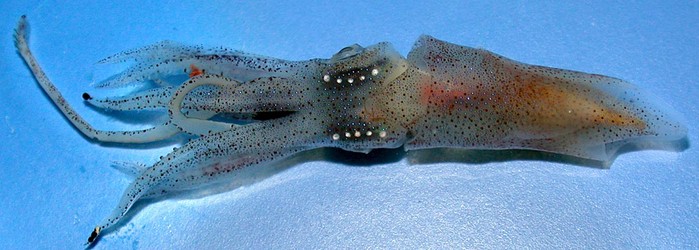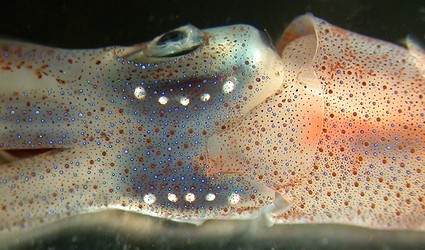Abraliopsis morisii
Kotaro TsuchiyaIntroduction
A. morisii is distributed widely in the tropical to warm temperate waters of the Atlantic Ocean. This species has a scattered arrangement of photophores on the ventral mantle and head, and carpal flaps and distinct aboral keels on the clubs. This is the only known species in the Atlantic in the species group (i.e., A. morisii, A. hoylei, A. tui and A. pacificus) that shares these characters.
Characteristics
- Tentacle clubs
- Two rows of different-sized hooks on manus.
- Carpal flap and aboral keel distinct.
- Arms
- Arms IV relatively long; ALI IV = ca.70.
- Arms with 14 - 22 hooks and suckers.
- Hectocotylus
- Hectocotylus with two different-sized flaps: long narrow proximal and short distal ones.
- Modified portion with armature.
- Integumental Photophores
- Ventral mantle and head with scattered arrangement of integumental organs.
- Ventral mantle and head with scattered arrangement of integumental organs.
Comments
This group with a scattered integumental photophore pattern, has few taxonomic characters but each species occupies a different watermass. They are identified by some morphometric or meristic characters such as fin length index, arm length index, hook and sucker count, etc. See detailed description (under preparation).
Nomenclature
This species was formerly called A. pfefferi Joubin, 1896. Bello (2005) after re-examining the original description of A. morisii, determined that discarding this name, which has precedence, due to problems with the original description, was a mistake and that the original discription was sufficient to identify the species. Unfortunately the type specimen appears to be lost. A. pfefferi, therefore, is a junior synonym of A. morisii.
Life history
Age and maturation
Based on statolith analyses, males mostly matured at 120-130 days and females at 150-160 days; minimum age at maturity is 105 days in males, 127 days in females (Arkhipkin, 1996).
Distribution
Geographical Distribution
Type locality: North Atlantic Ocean at 39°N, 20°W. This species is distributed in the tropical to warm temperate Atlantic Ocean, the Gulf of Mexico, and Mediterranean Sea (Nesis, 1982/87).
References
Bello, G. 2005. Abraliopsis morisii vs. Abraliopsis pfefferi (Cephalopoda: Enoploteuthidae): which is the right name? Journal of Conchology, 38 (5):561-565.
Arkhipkin, A.I. 1996. Age and growth of the squid Abraliopsis pfefferi (Oegopsida: Enoploteuthidae) from the central-east Atlantic based on the statolith microstructure. Scientia Marina 60:325-330.
Nesis, K. N. 1982. Abridged key to the cephalopod mollusks of the world's ocean. 385,ii pp. Light and Food Industry Publishing House, Moscow. (In Russian.). Translated into English by B. S. Levitov, ed. by L. A. Burgess (1987), Cephalopods of the world. T. F. H. Publications, Neptune City, NJ, 351pp.
Title Illustrations

| Scientific Name | Abraliopsis morisii |
|---|---|
| Location | North Atlantic, 43?N, 28?W |
| Comments | Photographed aboard the R/V G.O. SARS, during the MAR-ECO expedition 2004 |
| Specimen Condition | Fresh |
| View | Ventral |
| Copyright |
© Richard E. Young

|
About This Page

Tokyo University of Fisheries, Tokyo, Japan
Page copyright © 2000
- Content changed 14 August 2007
Citing this page:
Tsuchiya, Kotaro. 2007. Abraliopsis morisii . Version 14 August 2007 (under construction). http://tolweb.org/Abraliopsis_morisii/19691/2007.08.14 in The Tree of Life Web Project, http://tolweb.org/












 Go to quick links
Go to quick search
Go to navigation for this section of the ToL site
Go to detailed links for the ToL site
Go to quick links
Go to quick search
Go to navigation for this section of the ToL site
Go to detailed links for the ToL site